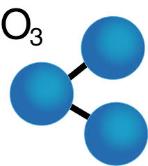
What is Ozone?
Ozone, known as O3, is a gas molecule made up of 3 oxygen atoms which share electrons. It is a unstable molecule that in a matter of seconds to minutes, will react with each other to form O2 or the oxygen gas molecule. Ozone has germicidal, bactericidal, and fungicidal properties, but also has the unique ability to activate the immune system by stimulating the production of cytokines. Cytokines are “messenger compounds” such as interferons and interleukins, which can cause a positive chain reaction throughout the body via their effect on the immune system. Depending on how the ozone therapy is utilized, it can enhance the immune system, or down regulate the immune system. This is important for helping with such chronic and frustrating conditions as neurologic disease, auto-immune disease, cancer, and allergies.
Ozone also has the ability to increase the delivery of oxygen to cells, this concept is known as oxygen utilization. When oxygen utilization is increased, the energy centers of the cell known as mitochondria, are able to increase cellular respiration, via the kreb’s cycle, which results in more energy for the body. This increased energy can be used by the cells of the immune system, various organs, nervous system, endocrine system, etc to allow increased efficiency, which with illness and disease, has been impaired.
Any chronic, degenerative disease can benefit from ozone therapy because of it’s ability to stimulate and stabilize biological functions. Ozone therapy itself does not cause the healing effect but rather induces the body’s own innate healing mechanisms. Ozone therapy is not typically a “stand alone” therapy, but used with other treatments including acupuncture, nutrition, herbs, and allopathic (western) medicine.
How is Ozone made?
Ozone is made by passing pure Oxygen gas (O2) through a tube though which electrical energy is directed. The energy breaks apart the molecules and creates both O2 and O3. Ozone cannot be made from room air because it contains nitrogen. The addition of nitrogen would cause the production of nitrous oxide which is known to be a toxin. For this reason, pure, medical grade oxygen is required to make the O3 for therapy.
How is Ozone administered?
There are several ways in which O3 can be administered to a patient. The most common applications are rectal or bladder insufflation, limb bagging, ozonated olive oil, major and minor autohemotherapy, and ozonated saline/ozonated gas injections. Rectal or bladder insufflation involves placing 50-150mls of the gas gently into the rectum or the bladder. This therapy allows direct contact of the gas with potentially harmful bacteria or cancer cells, but also allows absorption into the body to stimulate oxygen utilization. Treatments are typically administer 1-2 times weekly and then tapered off depending on the results and the condition being treated.
Limb bagging involves isolation of an leg or paw with a plastic bag and filling the bag with ozone gas. This technique is useful for wounds, decubital ulcers, and infections. Ozonated Olive Oil is ozone treated olive oil that can be applied topically to a desired location. It can be helpful with ringworm, yeast infections, bacterial infections, ear infections, bed sores, and ulcers.
Major and Minor Autohemotherapy involves the removal of a patients own blood and mixing it with the O3 in a sterile fashion. This is then carefully given back to the patient. This type of administration is most helpful with systemic conditions such as cancer, auto-immune diseases, immunodeficiency diseases, inflammatory disease, and systemic infections. Minor Autohemotherapy requires only a few milliliters of blood and this technique can be helpful with allergies.
Ozonated Saline involves bubbling the O3 through saline. This not only sterilizes the saline, but allows for safe administration into the body through subcutaneous administration or through IV administration. This can be helpful for painful conditions as well as chronic renal failure, and other systemic illness both acute and chronic in nature.
Ozone Gas itself can also be administered into the body. Prolozone therapy is a combination of prolotherapy and ozone gas injection and can be helpful with tendon/ligament injuries.
How often are the treatments?
Ozone therapy may be administered as frequently as twice per week. Typically treatments are done weekly and acute conditions may need 3-6 treatments. Patients with chronic conditions may require more treatments, at 1-2 month intervals.
Is Ozone treatment painful?
In the methods described above, ozone does not typically cause discomfort.
Is Ozone safe?
Ozone is extremely safe when used under direct medical supervision. The gas is almost immediately absorbed into the body, blood or saline because it is an unstable molecule by itself. Once it is absorbed, it has changed permanently. The smell of the gas itself can cause respiratory irritation and for this reason should not be directly inhaled.
